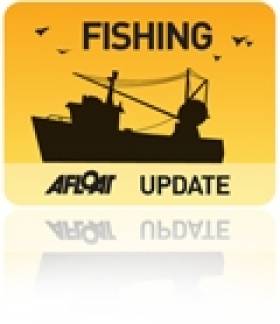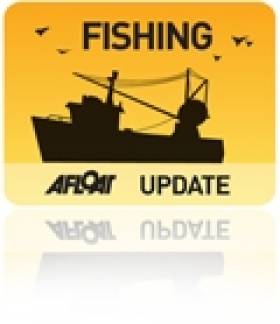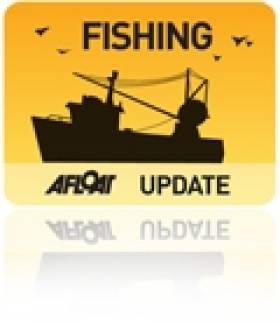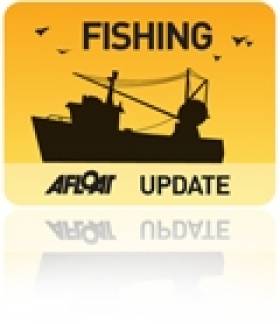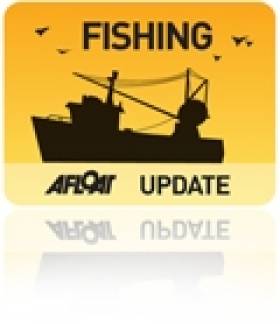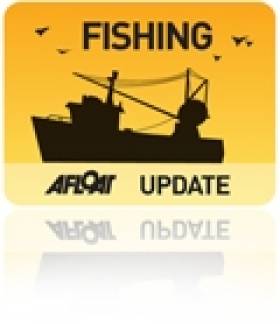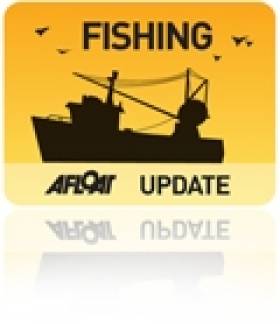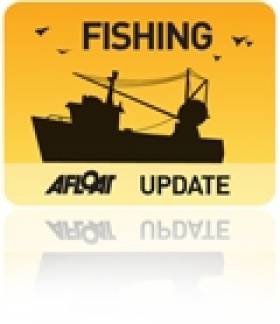Displaying items by tag: Seafood
#seafood – Minster for Agriculture, Food and the Marine, Simon Coveney TD today welcomed the EU Fisheries Commissioner, Karmenu Vella, to the Marine Institute in Galway.
Minister Coveney said "I am delighted to welcome Commissioner Vella to Ireland on his first official visit as Commissioner for Maritime Affairs and the Environment. While the Commissioner will have many opportunities over the coming days to learn about the overall importance of maritime affairs to Ireland, today our focus was on the seafood industry. In particular, this was an opportunity for me as Minister and the relevant stakeholders to provide the Commissioner with an overview on the seafood industry in Ireland and the challenges and opportunities in implementing the new reformed Common Fisheries Policy."
Commissioner Vella, who is responsible for Maritime Affairs and the Environment, is on a three day visit to Ireland during which he will have a number of engagements, the first of which was roundtable discussion with seafood industry stakeholders in the Marine Institute.
Minister Coveney hosted a discussion between the stakeholders - representing the catching sector, processors, the aquaculture sector as well as the environmental pillar – and the Commissioner during a two hour meeting today in the Marine Institute.
Minister Coveney went on to say "Today was a very valuable opportunity for seafood stakeholders to directly engage with Commissioner Vella and to express their views on a wide variety of issues of direct importance to coastal communities dependent on fisheries and aquaculture in Ireland. This kind of direct engagement will ensure that the Commissioner has a solid understanding of the issues of concern to Ireland as we implement the new CFP. In particular, stakeholders raised issues around the phasing in of the new discards ban or Landing obligation and the objective of achieving maximum sustainable yield or MSY by 2020 at the latest".
Marine Minister Announces Expanded & Wide-Ranging €241M Seafood Development Programme To 2020
#Seafood - Marine Minister Simon Coveney today (Friday 27 March) announced plans for a new €241-million development programme for the seafood sector for the period up to 2020.
The new programme will be co-funded by the EU through the European Maritime and Fisheries Fund and is subject to adoption by the European Commission.
A public consultation on the minister’s proposals for the new programme and a strategic environmental assessment were published today, with comments invited by 1 May 2015.
In announcing the new programme, Minister Coveney said: “Our seafood sector is worth in the region of €850 million annually to our economy, with exports growing by 70% since 2009 to €540 million. Seafood is widely recognised as a high growth area of our economy, with the potential to grow to €1 billion by 2020.
"The investment package I am announcing today will be a key element in achievement of that growth potential. It will provide the capital to assist seafood enterprises to sustainably grow their production, add value to our seafood exports and create much needed employment in our coastal communities.”
He went on to say that he "negotiated a doubling for the period to 2020 of the EU seafood development funds to Ireland. Under this programme, €147 million will be provided to Ireland under the European Maritime and Fisheries Fund. Government is providing an additional €94 million in co-funding, demonstrating our commitment to growing and developing the sector.”
The minister said he recognises "at the outset that there will be many views on how these funds would best be invested and on which particular areas should be prioritised.
"Following a detailed process of analysing the investment needs of the sector, I am proposing today that we invest €42 million in implementing the new Common Fisheries Policy, including measures for developing more selective fishing gear, and supporting the new discards ban.
"I am also proposing that we invest a further €6 million to build on the good work that has been ongoing over recent months to revive and sustainably grow our inshore fisheries; €30 million to sustainably develop our aquaculture industry and implement a new national plan for aquaculture that I will be announcing shortly; €12 million to grow the seafood based economies of our coastal communities through community-led fisheries local action aroups; and €41 million to grow markets for our seafood products, develop our seafood processing industry and develop new value added products for those markets.
"I am also making available almost €10 million to support implementation of EU environmental law, to help protect vulnerable habitats and species and ensure that our seafood sector continues to operate and grow in a sustainable manner.”
The Minister concluded by inviting comments on these proposals by 1 May, and said he looks forward "to considering all views and discussing them with stakeholders”.
18 Seafood Processing Companies Get €2.7m in Grant-Aid
#fishing – The Minister for Agriculture, Food and the Marine, Simon Coveney TD, announced today the award of €2.7 million in grant-aid to 18 seafood processing companies under the 2015 Seafood Processing Business Investment Scheme. Taken in conjunction with private sector investment, the total investment will be almost €9 million in 2015. The supported projects are projected to deliver 145 Jobs and €41 million in additional sales by 2017. The grants are co-funded by the Department of Agriculture Food and the Marine and the European Fisheries Fund under the Seafood Development Programme.
Minister Coveney, in stressing the value of this grant-aid package to the Seafood Processing industry said, "this investment of almost €9 million in 2015 will enable our innovative seafood processers to continue their strong growth trend over recent years that will see the sector continuing to grow sales internationally and grow employment in our coastal communities. It will put the required technology, infrastructure and standards in place to allow these businesses develop added value seafood products that are in great demand on the global market."
The Minister concluded "the Irish seafood processing industry generally, in line with Government policy under the Food Harvest 2020 plan, has strong plans to significantly grow its business further in the years ahead. I believe we can look forward with confidence to seeing the seafood processing sector continuing to be an integral part of Government's policy to grow our indigenous seafood industry".
Hong Kong Bans Donegal Oysters Over Food Poisoning Scare
#Seafood - Donegal's oyster industry has been hit by an import ban in Hong Kong over an outbreak of food poisoning.
According to The Irish Times, food safety investigators in the Chinese territory were notified by Irish authorities two weeks ago that the presence of norovirus was confirmed at a raw oyster processing plant in the north-eastern county that services the crucial Asian market.
Hong Kong subsequently banned the import of raw oysters from Donegal "for the sake of prudence". More HERE.
Shellfish Information Meetings Set For April & May
#Shellfish - The Food Safety Authority of Ireland (FSAI) is holding a series of Shellfish Regional Information Meetings around the coast in April and May.
The informal events, held in association with the Sea-Fisheries Protection Authority (SFPA), the Marine Institute and Bord Iascaigh Mhara (BIM), aim to provide an opportunity for all those involved in the shellfish industry to learn more about the role of the Shellfish Safety Monitoring Programme and how it assists industry to ensure that live bivalve molluscs placed on the market meet the highest standards of food safety.
This series of events will focus on microbiological classification of shellfish production areas but will also cover topics such as biotoxin and phytoplankton monitoring, phytoplankton sampling and viruses.
The first of these meetings takes place on 15 April at the SFPA office in Clonakilty, Co Cork, followed by 16 April at the Brehon Hotel in Killarney, Co Kerry.
On 27 April, the meeting moves to the Clann Ri Hotel in Letterkenny, Co Donegal, followed on 28 April at the Marine Institute in Oranmore, Co Galway.
The final meeting in the series will be held on 6 May at the FSAI office on Lower Abbey Street in Dublin city centre.
Registration for the events in Donegal, Galway, Cork and Dublin is from 1pm with a light lunch served. These sessions will run from 1:30pm to 4:30pm. In Kerry, registration is from 9:30am with tea/coffee served. The sessions will run from 10am to 1pm, when a light lunch will be served.
To register for one of these free half-day events, click on the any of the links above or phone Lorna Tallon on 01 817 1398.
Irish Seafood Takes Pride Of Place At World Organic Trade Fair
#Seafood - Three seafood companies were among the eight organic food businesses exhibiting at this year's Biofach event in Germany.
Kush Seafarms in Co Kerry, Irish Seaspray in Co Galway and the Irish Organic Salmon Company in Co Donegal all return after last year's exhibiting at the World Organic Trade Fair in Nuremberg.
And they were joined at the opening of their stand by Minister of State Tom Hayes, who reiterated the opportunities that exists for the organic food market at home and abroad.
“Participation in Biofach allows our organic producers and processors to showcase Irish organic produce on a worldwide stage," he said. “It also provides ample opportunities to network with purchasing decision makers, both from Europe and further afield.”
Minister Hayes also paid tribute to Bord Bia “for the professional way that they have organised the Irish food industry’s participation at this very important event.”
He concluded: “I wish all participants here today every success over the coming days and I hope that you develop the partnerships and contacts that will help your business continue to grow into the future.”
Eight innovative Irish seafood and food companies are participating at the event, which runs till Saturday 14 February.
Last year, Biofach attracted over 2,000 exhibitors and in excess of 42,000 trade visitors attended the event.
#Seafood - Lough Neagh eels may no longer be protected by Brussels regional designation rules if a proposed free trade deal with North America goes through.
As the Belfast Telegraph reports, the lough's eels are among a number of foodstuffs in Northern Ireland that come under EU Protected Geographical Indication, which means that only products produced in a particular area – like Cornish pasties or parmesan cheese – can be named and marketed as such.
But German agriculture minister Christian Schmidt has said that such protections, which are not recognised in the United States, may have to be abandoned "if we want to take advantage of the opportunities of free trade with the huge American market".
The Belfast Telegraph has more on the story HERE.
Minister Welcomes Outcome Of Ireland-Russia Talks On Meat, Dairy & Seafood Sectors
#Seafood - Marine Minister Simon Coveney welcomed the outcome of yesterday’s (18 December) high-level bilateral meeting in Moscow between his department and the Russian authorities on agri-food issues, including seafood.
The meeting was held at the request of the Department of Agriculture, Food and the Marine and built on the recent meeting in Dublin between the minister and the Ambassador of the Russian Federation to Ireland.
“Russia is an important market for Irish agri-food products but unfortunately this trade has been restricted by issues arising from the Russian ban on EU food and drink products as well as their audit of Ireland’s exporting plants earlier this year," said Minister Coveney.
"Through the Irish Embassy in Moscow we have been actively pursuing a bilateral meeting for some time to complement the intense engagement which we have had with Russian counterparts over the last few months. I am pleased to hear that yesterday’s meeting continued the constructive dialogue between both sides and progressed a number of key issues.”
The meeting focused on the department's response to the interim report on the audit findings received from the Russian authorities earlier this year.
The comprehensive response, incorporating the corrective actions for each establishment visited, has been submitted in full and the Russian side confirmed at the meeting that the final report will issue before the end of this month.
Commenting on this, the minister said that “confirmation that the final report will arrive before the end of the month was very welcome and gives us a solid basis for resolving these issues.
"We will prioritise our response to the final report with a view to having the temporary restrictions lifted on the affected dairy, beef and seafood plants as soon as possible.”
The meeting concluded with a proposal by both sides to meet again in January.
“I am under no illusion that considerable work remains to be done if we are to regain some of the market share prior to the events of this year," added Minister Coveney. "Equally it must be remembered that some of this market restriction is common to all EU Member States and stems from political issues unrelated to the agri-food sector.
"Nonetheless I am encouraged by the positive spirit in which this bilateral discussions took place and most importantly that there is a clear roadmap for future engagement and that another meeting is confirmed for January.
"In parallel to these discussions, I will be continuing my engagement with the European Commission and my counterparts from other EU states to ensure that the right market support measures are being deployed to help producers and processors in Ireland to help overcome the effects of the Russia ban."
Ireland’s agri-food trade to Russia in 2013 was worth €235m before EU sanctions were put in place.
Marine Institute Announces Boost For Seafood Research
#MarineScience - The Marine Institute has secured €800,000 research funding from the Department of Agriculture, Food and the Marine to carry out three significant research projects that address the needs of the aquaculture and seafood industry in the areas of shellfish health and seafood safety.
The funding was announced yesterday (Thursday 1 December) by Marine Minister Simon Coveney as part of the FIRM (Food Institutional Research Measure) competitive research funding programme, and follows the news earlier this month that Ireland's marine researchers won €5.5 million in the latest EU Horizon 2020 funding round in the areas of 'blue growth' and sustainability.
The collaborative projects, which have a total value of €1.2 million, include research partners at NUI Galway, University College Cork and University College Dublin.
The projects will address current challenges in aquaculture and aim to further enhance the health status and food safety standards of farmed Irish shellfish; and ensure compliance with food/feedstuff standards for seaweed.
Dr Peter Heffernan, chief executive of the Marine Institute, welcomed the announcement, saying these projects "will build on the work we are doing in the areas of fish health and seafood safety, together with our research partners.
"We have a strong seafood safety regime in Ireland and these research awards will help to increase our knowledge and further enhance the quality and safety of Irish seafood products."
Dr Heffernan also acknowledged two further research award recipients in NUI Galway and Dublin City University who will focus their research on sustainable aquaculture production systems and mining marine material for novel functional ingredients.
Early in the new year the Marine Institute will seek to fill the three research posts arising from these projects.
Clogherhead Trawlerman Is Named Young Fishmonger For 2015
#Seafood - A former trawlerman has been named as Bord Iascaigh Mhara's (BIM) Young Fishmonger for 2015, as The Irish Times reports.
Gerard Collier of Fisherman's Catch in Clogherhead was selected from a shortlist of five for the accolade, which recognises excellence in product knowledge, customer service and technical skill.
As previously reported on Afloat.ie, the winner receives a cash prize of €1,000 as well as a study trip to France, while he and his fellow finalists will get a set of professional knives and a place on BIM's retail development workshops, on top of their masterclass with from Kinsale-based chef Martin Shanahan.
"All of our finalists were exceptional throughout every stage of the competition and they should be very proud of their achievements," said Donal Buckley, BIM's business development and innovation director.
"Congratulations to our worthy winner Gerard Collier and his colleagues at Fisherman’s Catch, I hope this experience and the competition prize fund allows you to further develop what is a very successful family business."
Meanwhile, last year's winner James Kirwan of East Coast Seafood in Naas, Co Kildare, spoke of how the prize money allowed him to install a new kitchen in the shop to produce a range of fish soups, burgers and pies, while the study trip "was a real learning curve for me in terms of understanding customers' preferences."
The Irish Times has more on the story HERE.



























